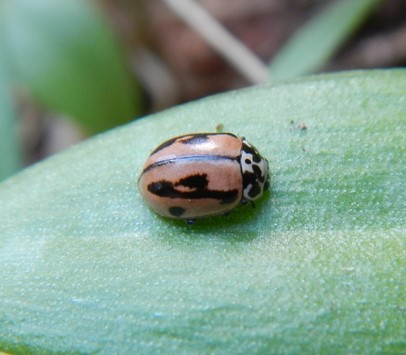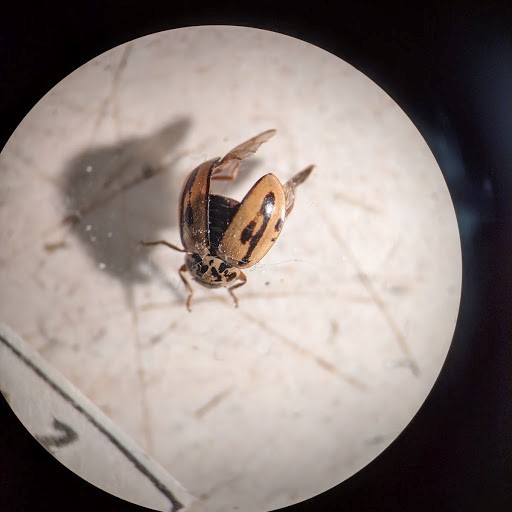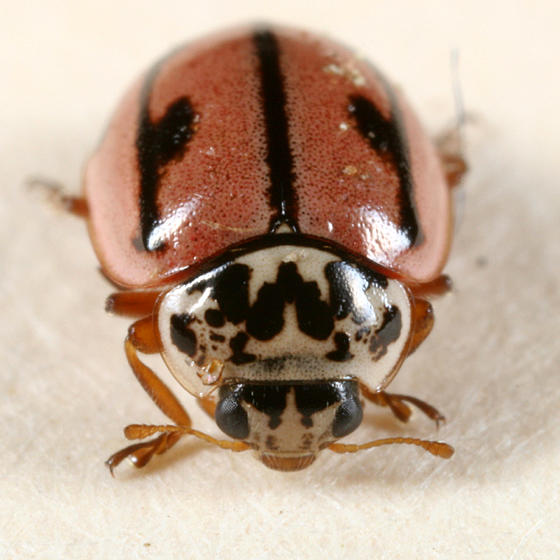
Hudsonian Ladybird
© Colin Chapman-Lam
The Hudsonian Ladybird is an important predator of aphids in spruce-fir forests, particularly the Balsam Twig Aphid. The species is orangish-red to brown in color, with a pattern on its wing covers that looks like two percent signs separated by a centerline.
Status
Native
Global Status: Secure
Last Seen
2021
Fun Fact
The Hudsonian Ladybird was named after the Hudson Bay, and both plays dead and “reflex bleeds” (exude a noxious fluid) as defense mechanisms.
Identification
The Hudsonian Ladybird is 3 to 5 mm in length.
- Head: White to off-white in color, with a black margin or patch at the top of the head. Two symmetrical, interrupted lines extend from this black margin or patch down the head towards the mouth.
- Pronotum: White to light yellowish-brown in color. There is a black complete or interrupted “M” shape on the pronotum. There are irregularly-shaped black spots on either side of the “M” as well, occasionally connected to it. The posterior margin of the pronotum can be pale or black.
- Elytra: Orangish-red to brownish in color. The suture (where the wing covers come together when closed) is black. Two black lines extend down the elytra, parallel to the suture (one centered on each elytron), with one black spot on each side of these lines (resembles a % sign on each elytron). The two inner black spots are sometimes connected to the black line running down the elytron.
- The whole beetle is punctured (appears like it was pricked with a pin many times).
- Legs are orange.
- Often confused with the Painted Lady Beetle, Streaked Lady Beetle,
Habitat
Conifer or mixed forests. May have a preference for spruce-fir forests, particularly the lower canopy.
General Range
In the north, the Hudsonian Ladybird’s range is transcontinental, from Alaska to Newfoundland, south to the Great Lakes through northern Georgia.
Food
Consumes aphids that are associated with conifers, such as the Balsam Twig Aphid. Will eat other aphids and scale insects associated with conifers, along with pollen and honeydew.
Life Cycle
In the northern parts of their range, Hudsonian Ladybirds have one generation per year. Overwintering adults emerge in the beginning of May, and breeding occurs from mid-May to mid-June. Egg laying begins around eight days after mating commences, and eggs are laid over a period of around 20 days. Eggs hatch from mid-June to mid-July. Larvae develop through their four instar phases over a period of around 18 days, then pupate for around eight days. Adults emerge between mid-July and early August. Hudsonian Ladybirds do not seem to migrate, and likely overwinter on the forest floor. They closely synchronize their life cycle with their prey.
More Information
You can find more information about Hudsonian Ladybirds using the following links:
- iNaturalist Species Account
- Bug Guide Info page
- Living Atlas Species Profile
Vermont Distribution
Visit the iNaturalist Observation Map and Observation Records to find out where Hudsonian Ladybirds have been seen in Vermont.








